Lysosomal dysfunction in a mouse model of Sandhoff disease leads to accumulation of ganglioside-bound amyloid-β peptide
- PMID: 22496568
- PMCID: PMC6622109
- DOI: 10.1523/JNEUROSCI.4860-11.2012
Lysosomal dysfunction in a mouse model of Sandhoff disease leads to accumulation of ganglioside-bound amyloid-β peptide
Abstract
Alterations in the lipid composition of endosomal-lysosomal membranes may constitute an early event in Alzheimer's disease (AD) pathogenesis. In this study, we investigated the possibility that GM2 ganglioside accumulation in a mouse model of Sandhoff disease might be associated with the accumulation of intraneuronal and extracellular proteins commonly observed in AD. Our results show intraneuronal accumulation of amyloid-β peptide (Aβ)-like, α-synuclein-like, and phospho-tau-like immunoreactivity in the brains of β-hexosaminidase knock-out (HEXB KO) mice. Biochemical and immunohistochemical analyses confirmed that at least some of the intraneuronal Aβ-like immunoreactivity (iAβ-LIR) represents amyloid precursor protein C-terminal fragments (APP-CTFs) and/or Aβ. In addition, we observed increased levels of Aβ40 and Aβ42 peptides in the lipid-associated fraction of HEXB KO mouse brains, and intraneuronal accumulation of ganglioside-bound Aβ (GAβ) immunoreactivity in a brain region-specific manner. Furthermore, α-synuclein and APP-CTFs and/or Aβ were found to accumulate in different regions of the substantia nigra, indicating different mechanisms of accumulation or turnover pathways. Based on the localization of the accumulated iAβ-LIR to endosomes, lysosomes, and autophagosomes, we conclude that a significant accumulation of iAβ-LIR may be associated with the lysosomal-autophagic turnover of Aβ and fragments of APP-containing Aβ epitopes. Importantly, intraneuronal GAβ immunoreactivity, a proposed prefibrillar aggregate found in AD, was found to accumulate throughout the frontal cortices of postmortem human GM1 gangliosidosis, Sandhoff disease, and Tay-Sachs disease brains. Together, these results establish an association between the accumulation of gangliosides, autophagic vacuoles, and the intraneuronal accumulation of proteins associated with AD.
Figures
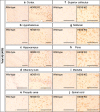
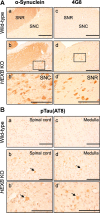
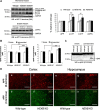
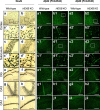
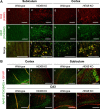
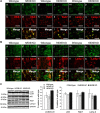
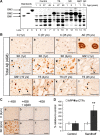
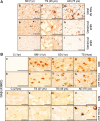
Similar articles
-
Apoptotic cell death in mouse models of GM2 gangliosidosis and observations on human Tay-Sachs and Sandhoff diseases.Hum Mol Genet. 1997 Oct;6(11):1879-85. doi: 10.1093/hmg/6.11.1879. Hum Mol Genet. 1997. PMID: 9302266
-
Characterization of the testis and epididymis in mouse models of human Tay Sachs and Sandhoff diseases and partial determination of accumulated gangliosides.Endocrinology. 1998 Jul;139(7):3280-8. doi: 10.1210/endo.139.7.6117. Endocrinology. 1998. PMID: 9645704
-
Specific induction of macrophage inflammatory protein 1-alpha in glial cells of Sandhoff disease model mice associated with accumulation of N-acetylhexosaminyl glycoconjugates.J Neurochem. 2005 Mar;92(6):1497-507. doi: 10.1111/j.1471-4159.2005.02986.x. J Neurochem. 2005. PMID: 15748167
-
Ganglioside-Mediated Assembly of Amyloid β-Protein: Roles in Alzheimer's Disease.Prog Mol Biol Transl Sci. 2018;156:413-434. doi: 10.1016/bs.pmbts.2017.10.005. Epub 2018 Feb 1. Prog Mol Biol Transl Sci. 2018. PMID: 29747822 Review.
-
Abeta polymerization through interaction with membrane gangliosides.Biochim Biophys Acta. 2010 Aug;1801(8):868-77. doi: 10.1016/j.bbalip.2010.01.008. Epub 2010 Feb 1. Biochim Biophys Acta. 2010. PMID: 20117237 Review.
Cited by
-
The role of autophagy in neurodegenerative disease.Nat Med. 2013 Aug;19(8):983-97. doi: 10.1038/nm.3232. Epub 2013 Aug 6. Nat Med. 2013. PMID: 23921753 Review.
-
Intracellular metalloprotease activity controls intraneuronal Aβ aggregation and limits secretion of Aβ via exosomes.FASEB J. 2019 Mar;33(3):3758-3771. doi: 10.1096/fj.201801319R. Epub 2018 Nov 27. FASEB J. 2019. PMID: 30481490 Free PMC article.
-
Is human immunodeficiency virus-mediated dementia an autophagic defect that leads to neurodegeneration?CNS Neurol Disord Drug Targets. 2014;13(9):1571-9. doi: 10.2174/1871527313666140806125841. CNS Neurol Disord Drug Targets. 2014. PMID: 25106633 Free PMC article. Review.
-
Integrative Single-Plaque Analysis Reveals Signature Aβ and Lipid Profiles in the Alzheimer's Brain.Anal Chem. 2024 Jun 18;96(24):9799-9807. doi: 10.1021/acs.analchem.3c05557. Epub 2024 Jun 3. Anal Chem. 2024. PMID: 38830618 Free PMC article.
-
RT-DOb, a switch gene for the gene pair {Csf1r, Milr1}, can influence the onset of Alzheimer's disease by regulating communication between mast cell and microglia.PLoS One. 2023 Jul 6;18(7):e0288134. doi: 10.1371/journal.pone.0288134. eCollection 2023. PLoS One. 2023. PMID: 37410787 Free PMC article.
References
-
- Bahr BA, Bendiske J. The neuropathogenic contributions of lysosomal dysfunction. J Neurochem. 2002;83:481–489. - PubMed
-
- Barelli H, Lebeau A, Vizzavona J, Delaere P, Chevallier N, Drouot C, Marambaud P, Ancolio K, Buxbaum JD, Khorkova O, Heroux J, Sahasrabudhe S, Martinez J, Warter JM, Mohr M, Checler F. Characterization of new polyclonal antibodies specific for 40 and 42 amino acid-long amyloid beta peptides: their use to examine the cell biology of presenilins and the immunohistochemistry of sporadic Alzheimer's disease and cerebral amyloid angiopathy cases. Mol Med. 1997;3:695–707. - PMC - PubMed
Publication types
MeSH terms
Substances
LinkOut - more resources
Full Text Sources
Other Literature Sources
Molecular Biology Databases
Research Materials
Miscellaneous
